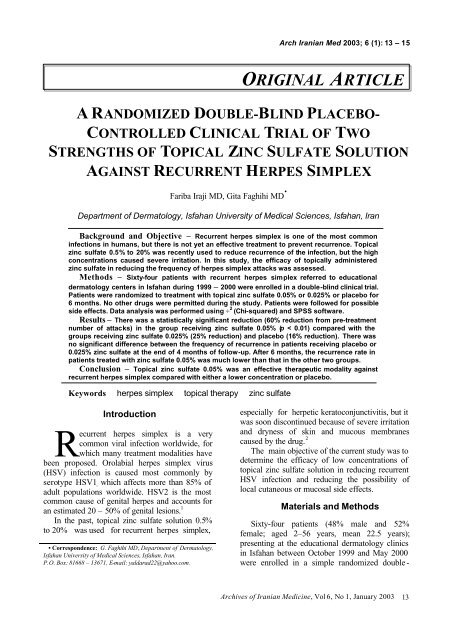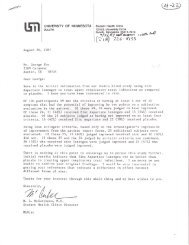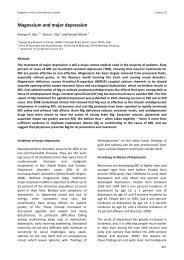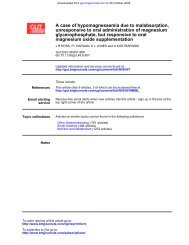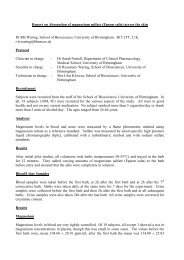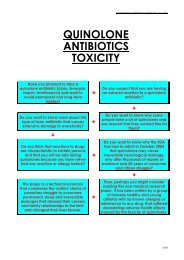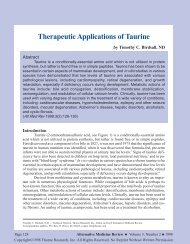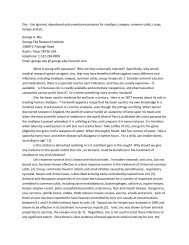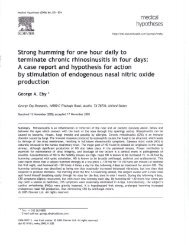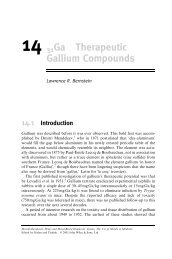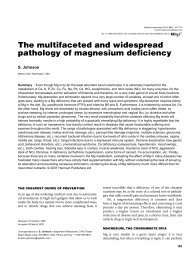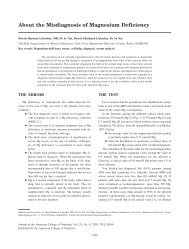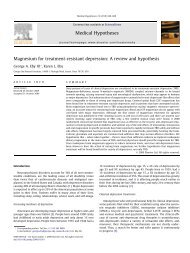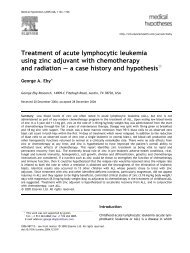2003 article - George Eby Research Institute
2003 article - George Eby Research Institute
2003 article - George Eby Research Institute
Create successful ePaper yourself
Turn your PDF publications into a flip-book with our unique Google optimized e-Paper software.
Arch Iranian Med <strong>2003</strong>; 6 (1): 13 – 15<br />
A RANDOMIZED DOUBLE-BLIND PLACEBO-<br />
CONTROLLED CLINICAL TRIAL OF TWO<br />
STRENGTHS OF TOPICAL ZINC SULFATE SOLUTION<br />
AGAINST RECURRENT HERPES SIMPLEX<br />
Fariba Iraji MD, Gita Faghihi MD •<br />
Department of Dermatology, Isfahan University of Medical Sciences, Isfahan, Iran<br />
Background and Objective – Recurrent herpes simplex is one of the most common<br />
infections in humans, but there is not yet an effective treatment to prevent recurrence. Topical<br />
zinc sulfate 0.5% to 20% was recently used to reduce recurrence of the infection, but the high<br />
concentrations caused severe irritation. In this study, the efficacy of topically administered<br />
zinc sulfate in reducing the frequency of herpes simplex attacks was assessed.<br />
Methods – Sixty-four patients with recurrent herpes simplex referred to educational<br />
dermatology centers in Isfahan during 1999 – 2000 were enrolled in a double-blind clinical trial.<br />
Patients were randomized to treatment with topical zinc sulfate 0.05% or 0.025% or placebo for<br />
6 months. No other drugs were permitted during the study. Patients were followed for possible<br />
side effects. Data analysis was performed using ÷ 2 (Chi-squared) and SPSS software.<br />
Results – There was a statistically significant reduction (60% reduction from pre-treatment<br />
number of attacks) in the group receiving zinc sulfate 0.05% (p < 0.01) compared with the<br />
groups receiving zinc sulfate 0.025% (25% reduction) and placebo (16% reduction). There was<br />
no significant difference between the frequency of recurrence in patients receiving placebo or<br />
0.025% zinc sulfate at the end of 4 months of follow-up. After 6 months, the recurrence rate in<br />
patients treated with zinc sulfate 0.05% was much lower than that in the other two groups.<br />
Conclusion – Topical zinc sulfate 0.05% was an effective therapeutic modality against<br />
recurrent herpes simplex compared with either a lower concentration or placebo.<br />
Keywords herpes simplex topical therapy zinc sulfate<br />
ORIGINAL ARTICLE<br />
Introduction<br />
R<br />
ecurrent herpes simplex is a very<br />
common viral infection worldwide, for<br />
which many treatment modalities have<br />
been proposed. Orolabial herpes simplex virus<br />
(HSV) infection is caused most commonly by<br />
serotype HSV1 , which affects more than 85% of<br />
adult populations worldwide. HSV2 is the most<br />
common cause of genital herpes and accounts for<br />
an estimated 20 – 50% of genital lesions. 1<br />
In the past, topical zinc sulfate solution 0.5%<br />
to 20% was used for recurrent herpes simplex,<br />
• Correspondence: G. Faghihi MD, Department of Dermatology,<br />
Isfahan University of Medical Sciences, Isfahan, Iran.<br />
P.O. Box: 81668 – 13671, E-mail: yaldarad22@yahoo.com.<br />
especially for herpetic keratoconjunctivitis, but it<br />
was soon discontinued because of severe irritation<br />
and dryness of skin and mucous membranes<br />
caused by the drug. 2<br />
The main objective of the current study was to<br />
determine the efficacy of low concentrations of<br />
topical zinc sulfate solution in reducing recurrent<br />
HSV infection and reducing the possibility of<br />
local cutaneous or mucosal side effects.<br />
Materials and Methods<br />
Sixty-four patients (48% male and 52%<br />
female; aged 2–56 years, mean 22.5 years);<br />
presenting at the educational dermatology clinics<br />
in Isfahan between October 1999 and May 2000<br />
were enrolled in a simple randomized double -<br />
Archives of Iranian Medicine, Vol 6, No 1, January <strong>2003</strong> 13
Topical Zinc Sulfate for Recurrent Herpes Simplex<br />
Table 1. The prevalence of different anatomic<br />
sites of HSV involvement in patients.<br />
Anatomic site<br />
Prevalence rate<br />
Orofacial 69%<br />
Genital 18%<br />
Limbs 12.5%<br />
Trunk 11%<br />
blind placebo-controlled clinical trial. All fulfilled<br />
following criteria:<br />
1- At least one attack of herpes infection during<br />
the past two months and recurrent HSV infection;<br />
2- No history of drug hypersensitivity,<br />
pregnancy and breast-feeding (at the time of<br />
study); and<br />
3- No medications other than the study drug.<br />
Patients were randomly divided into three<br />
treatment groups. In the first group, lesions were<br />
compressed with 0.025% zinc sulfate solution<br />
(Alhavi Pharm Co, Iran) made by dissolving the<br />
salt in 0.9% saline solution. The dressing remained<br />
in place for ten minutes once daily during the acute<br />
phase, for ten minutes once weekly for one month,<br />
and for ten minutes every two weeks until the end<br />
of the follow-up period (total 6 months). In the<br />
second group, lesions were compressed with 0.05%<br />
zinc sulfate solution. The treatment protocol was<br />
the same as that for the first group. In the last<br />
group, a placebo compress was applied according<br />
to the same protocol. Zinc sulfate was not applied<br />
to oral mucosal lesions due to side effects such as<br />
irritation and nausea.<br />
All patients were visited at 14-day intervals for<br />
one month and then at monthly intervals to the end<br />
of the 6 months. At each visit, the number of<br />
attacks, patient tolerance, any complications and<br />
subjective symptoms were recorded. Data were<br />
analyzed using ÷ 2 and SPSS software. The<br />
statistical power was â = 0.9 and the probability of<br />
first-degree error was á = 0.05.<br />
Results<br />
A total of 20 patients (31.3%) were<br />
immunocompromised due to diabetes mellitus,<br />
immunosuppressive therapy, leukemia or HIV<br />
infection. The most prevalent anatomic sites of<br />
HSV involvement are shown in Table 1.<br />
The results are summarized in Table 2. At the<br />
end of the 4 th month of follow-up, there were no<br />
significant differences in the recurrence rate of<br />
HSV among the three groups of patients. At the<br />
end of the 6-month follow-up period, there was a<br />
statistically significant reduction (60% compared<br />
to pre-treatment number of attacks) in the group<br />
treated with zinc sulfate 0.05% (p < 0.01)<br />
compared with the groups treated with zinc sulfate<br />
0.025% (25% reduction) and placebo (16%<br />
reduction).<br />
No serious complications occurred in any of<br />
our patients during treatment. There was no<br />
difference in the results with zinc sulfate 0.025%<br />
and placebo in our patients (p > 0.05).<br />
Discussion<br />
Zinc ions inhibit the activity of HSV-specified<br />
DNA polymerase, like other well-known<br />
therapeutic agents (e.g. acyclovir), but the<br />
hypothesis that zinc might block HSV replication<br />
by selective intranuclear inhibition of viral DNA<br />
polymerase appears to have lost its validity. 3 It is<br />
thought that zinc binds to sulfhydryl groups of<br />
viral glycoprotein B and that when zinc<br />
accumulates in the virion, glycoprotein functions<br />
are inhibited, leading to the dramatic antiviral<br />
effect. 4 The daily topical application of zinc<br />
sulfate 0.1% was apparently successful in longterm<br />
prevention of HSV reactivation. 5 In a small<br />
controlled trial, ten-minute soaking with zinc<br />
sulfate solution (0.025 – 0.05% in water) on the<br />
expected site of herpes simplex reactivation<br />
(repeated two to four times monthly) did not show<br />
any therapeutic response. 2<br />
In another study, however, topical application<br />
of zinc sulfate 0.05% reduced the frequency of<br />
herpetic attacks during a period of 16 – 23<br />
months. 6 A third report showed that topical<br />
treatment with zinc sulfate 0.5% gave the same<br />
results, but the 10-fold rise in concentration again<br />
Table 2. The results of treatment in three different groups of patients.<br />
Total number of attacks<br />
Groups of patients Reduction rate Baseline 4 months 6 months<br />
Placebo 16% 77 70 65<br />
Zinc sulfate 0.025% 25% 61 50 46<br />
Zinc sulfate 0.05% 60% 62 48 25<br />
Comparing the results of placebo and zinc sulfate 0.025%: p > 0.05. Comparing the results of zinc sulfate 0.05% with the other groups: p < 0.01.<br />
14<br />
Archives of Iranian Medicine, Vol 6, No 1, January <strong>2003</strong>
F. Iraji, G. Faghihi<br />
caused some irritation. 7<br />
Humoral and cell-mediated immunity do not<br />
fully protect against recurrent herpes simplex, but<br />
where immunity is deficient, recurrent herpetic<br />
infection may be more frequent and more severe.<br />
8, 9 In our study, 31.3% of patients had some<br />
degree of immunodeficiency. These patients<br />
responded less to treatment than immunocompetent<br />
individuals. Mild uncomplicated<br />
eruptions of herpes simplex require no treatment,<br />
but frequent recurrences and any associated<br />
erythema multiform should be suppressed by safe<br />
10, 11<br />
and cost-effective long-term treatment.<br />
Zinc can also regulate human DNA and RNA<br />
polymerases and thymidine kinase, so plays an<br />
important role in normal immunological<br />
12 – 14<br />
functions.<br />
Zinc ions have been reported to be antiviral to<br />
HSV. Long-term topical application of zinc salts<br />
appears to greatly reduce or eliminate recurrence<br />
of genital herpetic infections. 15 Zinc ions can<br />
precipitate protein, and Sharquie et al clearly<br />
showed that zinc sulfate causes very high<br />
inhibition of growth of amastigotes of Leishmania<br />
spp. 16 Thus, zinc sulfate has been used to treat<br />
oriental sores. Zinc monoglycerolate is also<br />
effective against oral herpetic sores. 17<br />
Further studies must be carried out to<br />
determine the mechanisms of the response of<br />
HSV infection to zinc ions, which could be<br />
through enhancement of the host’s cellular<br />
immunity.<br />
Acknowledgments<br />
We wish to thank Dr. M.R. Radan MD, for<br />
his assistance in drafting the manuscript. Our<br />
regards also go to the <strong>Research</strong> Council of<br />
Isfahan University of Medical Sciences and the<br />
Head of the Dermatology Department and the<br />
Manager of International and Foreign Affairs of<br />
Isfahan University of Medical Sciences, School of<br />
Medicine.<br />
References<br />
1 Nahmias AJ. Sero -epidemiological and sociological<br />
patterns of herpes simplex virus infection in the world.<br />
Scand J Infect Dis Suppl. 1990; 69: 19 – 36.<br />
2 Graham RM, James MP, Bennett S. Low concentration<br />
zinc sulphate solution in the management of recurrent<br />
herpes simplex infection. Br J Dermatol. 1985; 112:<br />
123 – 4.<br />
3 Kumel G, Schrader S, Zentgraf H, et al. The mechanism<br />
of the antiherpetic activity of zinc sulfate. J Gen Virol.<br />
1990; 71: 2989 – 97.<br />
4 Kumel G, Schrader S, Zentgraf H, et al. Therapy of<br />
banal HSV lesions: molecular mechanisms of the<br />
antiviral activity of zinc sulfate [in German]. Hautarzt.<br />
1991; 42: 439 – 45.<br />
5 Highet AS, Kurtz J. Viral infections. In: Rook A,<br />
Wilkinson DS, Ebling FJG, et al, eds. Textbook of<br />
Dermatology. Oxford: Blackwell Scientific; 1998: 2892.<br />
6 Brody I. Topical treatment of recurrent herpes simplex<br />
and post herpetic erythema multiform with low<br />
concentrations of zinc sulphate solution. Br J Dermatol.<br />
1981; 104: 191 – 4.<br />
7 Arens M, Travis S. Zinc salts inactivate clinical isolates<br />
of herpes simplex virus in vitro. J Clin Microbiol. 2000;<br />
38: 1758 – 62.<br />
8 Goldgeier MH, Cohen SR, Braverman IM, et al. An<br />
unusual and fatal case of disseminated cutaneous herpes<br />
simplex infection in a patient with cutaneous T-cell<br />
lymphoma (mycosis fungoides). J Am Acad Dermatol.<br />
1981; 4: 176 – 80.<br />
9 Greenberg MS, Friedman H, Cohen SG, et al. A<br />
comparative study of herpes simplex infections in renal<br />
transplant and leukemic patients. J Infect Dis. 1987; 156:<br />
280 – 7.<br />
10 Huff JC. Acyclovir for recurrent erythema multiform<br />
caused by herpes simplex. J Am Acad Dermatol. 1988;<br />
18: 197 – 9.<br />
11 Mindel A, Faherty A, Carney O, et al. Dosage and safety<br />
of long-term suppressive acyclovir therapy for recurrent<br />
genital herpes. Lancet. 1988; 1: 926 – 8.<br />
12 Lonnerdal B, Stanislowski AG, Hurley LS. Isolation of a<br />
low-molecular-weight zinc binding ligand from human<br />
milk. J Inorg Biochem. 1980; 12: 71 – 8.<br />
13 Lutz G, Kreysel HW. Selective changes in lymphocytic<br />
differentiation antigens in the peripheral blood of patients<br />
with alopecia areata treated with oral zinc [in German]. Z<br />
Hautkr. 1990; 65: 132 – 4, 137 – 8.<br />
14 Tong TK, Andrew LR, Albert A, et al. Childhood<br />
acquired immunodeficiency syndrome manifesting as<br />
acrodermatitis enteropathica. J Pediatr. 1986; 108:<br />
426 – 8.<br />
15 <strong>Eby</strong> GA, Halcomb WW. Use of topical zinc to prevent<br />
recurrent herpes simplex infection: review of literature<br />
and suggested protocols. Med Hypotheses. 1985; 17:<br />
157 – 65.<br />
16 Sharquie E, Najim RA, Farjou IB, et al. A comparative<br />
controlled trial of intralesionally-administered zinc<br />
sulfate, hypertonic sodium chloride and pentavalent<br />
antimony compound against acute cutaneous<br />
leishmaniasis. J Clin Exp Dermatol. 1997; 22: 69 – 73.<br />
17 Apisariyakulm A, Buddhasukh D, Apisariyakul S, et al.<br />
Zinc monoglycerolate is effective against oral herpetic<br />
sores. Med J Aust. 1990; 152: 54.<br />
Archives of Iranian Medicine, Vol 6, No 1, January <strong>2003</strong> 15


